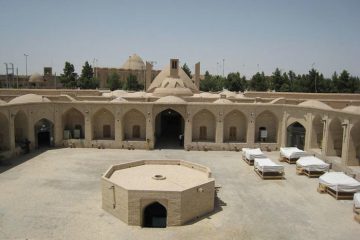Towers of Silence | How Zoroastrians Farewelled Their Dead
Towers of Silence in Yazd city are raised circular structures where Zoroastrians would leave the dead bodies to deflesh since ancient times. As one of the main Yazd attractions, no tourist affords to miss a visit to the daunting Towers of Silence.
Now, Where is the Tower of Silence? Well-preserved Zoroastrian Towers of Silence are found in Yazd, which is home to the majority of Zoroastrian community in Iran. Towers of Silence offer visitors an unmissable story behind Zoroastrian beliefs, on top of all, the answer to the much-asked question: What did Zoroastrians do with dead bodies and why?

Tower of Silence in Yazd
If you are interested in visiting Iran one day, as an Iran tour operator, we invite you to check out our Iran tours as well:
>> Iran Tours 2020 & 2021 (Click Here)
#1 Zoroastrian Towers of Silence
Zoroastrian Towers of Silence : According to Zoroastrian belief, the four elements of fire, water, earth and air are sacred, and must not be polluted by the disposal of the dead. While Cremation, for example, is believed to cause pollution to fire, air, and possible rivers, burial pollutes the earth and ground water.
Since burial in the earth was so abhorred, earlier in history, corpses were entombed in stone coffins during different eras (as such the free-standing tomb of Cyrus the Great, or cliff-cut necropolis of Naqsh-e Rustam).

Zoroastrian priests wear masks covering their mouths and noses so that the fire is not desecrated by their breath or saliva.
Zoroastrians, hence believed exposing of the dead to scavenging animals, such as vultures, was the best way to prevent tainting the earth, which later developed into the idea of constructing the towers of silence, which in Persian are called “Dakhma” or “Dakhmeh”.
The English term “Tower of Silence” is a coined term attributed to Robert Murphy, a translator for the British colonial government of India in the early 19th century.
#2 Where is the Tower of Silence?
Where is the Tower of Silence? Towers of Silence (or Dakhma) were constructed atop hills or low mountains in desert locations distant from population centers.
Today, the only extant towers of Silence are found in Iran (cities like Yazd, Kerman, Shiraz, …) and India, where Parsi communities exist.
In Iran, function of towers of silence were completely banned in 1970’s due to expansion of cities and growing population, and hygiene concerns; hence Zoroastrians resorted to Cremation or burial under specific conditions: The graves were lined with rocks and plastered with cement to prevent direct contact with the earth.

View of the city of Yazd from atop towers of Silence
#3 What did Zoroastrians Do with Dead Bodies?
What did Zoroastrians Do with Dead Bodies? Towers of Silence (Dakhma) were essentially raised platforms with three concentric circles within them. Raised walls were intended to obstruct sighting of the disintegration process.
Male bodies were arranged on the outer circle, females’ in the middle circle, and those of children in the inner circle. The dead were left on the tower of silence, where their flesh would be eaten by vultures.

Schematics of a tower of Silence
The person in charged of handling the corpses was called (Nasa-Salar), who after laying the bodied would unwrap the cloth (or Kafan) and leave the tower.
After the skeletons were stripped of flesh, the Nasa- Salar would discard them in an ossuary pit in the middle of the circles (called Ostoodan or Astodan), or outside the tower. Adding corrosive solutions of lime and Sulphur (called Tiz-Ab) would also accelerate decomposition of the remaining bones and be washed away with rainwater into 4 other wells surrounding the pit.
He would then recite the phrase “May God bless the deceased”.

Ossuary Pit or “Astodan” inside the Tower of Silence
#4 How would Mourning Families Perform Funerary Rituals?
How would Mourning Families Perform Funerary Rituals? Considering Towers of Silence were built away from villages, relatives of the deceased would have to go a long way to get to the towers. Hence, for their accommodation, shelters were built in the vicinity of the towers of silence (called Khayleh), dedicated to each village, where the mourning families would perform the religious rituals.
Each Khayleh had distinct chambers serving as the kitchen, ceremonial hall, etc.

Accommodation and Ceremony Chambers
#5 History of Towers of Silence in Yazd
History of Towers of Silence in Yazd : Towers of silence in Yazd are among the few well-preserved towers in Iran, hence attracting many visitors. There are 2 towers of silence on the site, called “Golestan” and “Maneckji”.
They were built, in the 19th century during the reign of Nassereddin Shah of Qajar Dynasty, by an Iranian Parsee “ Maneckji Limji Hatriya”. He was sent to Iran by the Parsee community of India, who had heard about the cruelty and neglect towards the Zoroastrians of Iran in that era, to negotiate with the king.
He devoted his whole life and resources to improve the quality of life for his fellow Zoroastrians, building schools, funding students, etc. His most prominent service was lifting Jaziyeh (hefty taxes imposed on Zoroastrians).
He passed away in Tehran, 1890.

Towers of Silence in Yazd, Opening Hours and Address
Opening Hours are : 9 am to 5 pm, Everyday



1 Comment
Colette · July 8, 2019 at 9:35 am
Interesting information! Is the site suitable to visit for people with walking difficulty, considering the stairs?